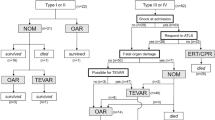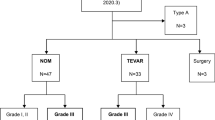Abstract
Background
Blunt traumatic aortic injury (BTAI) patients are severely ill, with high mortality and morbidity. As 60% of BTAIs occur in the distal arch, left subclavian artery (LSCA) management is determined without knowing posterior cerebral or left arm circulation in emergent cases. Because we perform thoracic endovascular aortic repair (TEVAR) + debranching technique for thoracic BTAI, we assessed efficacy and safety of debranching TEVAR in BTAI patients.
Methods
We retrospectively reviewed vital signs on arrival, injury mechanism, characteristics, clinical time-series, concomitant injuries, injury description, operative procedures, and results from patient records. We excluded patients in cardiopulmonary arrest on arrival.
Results
From April 2014 to December 2018, nine of 25 patients admitted with BTAI underwent TEVAR. Median Injury Severity Score was 34 (29–34) and probability of survival was 0.82 (0.16–0.94). Society for Vascular Surgery BTAI injury grade was III or IV in all patients. Three patients underwent simple TEVAR and six underwent debranching TEVAR (LSCA occlusion + left common carotid artery to LSCA bypass). Median operation time was 108 (75–157) min for simple TEVAR and 177 (112–218) min for debranching TEVAR. Concomitant injuries included intracranial hemorrhage (N = 1), intra-abdominal injuries (N = 3), pneumo- or hemothoraxes (N = 4) and pelvic/extremities fractures (N = 7). Only one complication of left-hand claudication occurred postoperatively in a patient with simple TEVAR with LSCA occlusion.
Conclusion
Despite debranching TEVAR taking approximately 60 min longer than simple TEVAR, short-term results indicated it to be acceptable for BTAI in multiple trauma patients to avoid LSCA complications unless we fail to stop bleeding first.



Similar content being viewed by others
Abbreviations
- BTAI:
-
Blunt traumatic aortic injury
- CT:
-
Computed tomography
- ISS:
-
Injury severity score
- LCCA:
-
Left common carotid artery
- LSCA:
-
Left subclavian artery
- SVS:
-
Society for vascular surgery
- TEVAR:
-
Thoracic endovascular aortic repair
References
Baker CC, Oppenheimer L, Stephens B, Lewis FR, Trunkey DD. Epidemiology of trauma deaths. Am J Surg. 1980;140:144–50.
Mattox KL. Approaches to trauma involving the major vessels of the thorax. Surg Clin N Am. 1989;69:7–87.
Brenner M, Teeter W, Hadud M, Hoehn M, O’Connor J, Stein D, et al. Long-term outcomes of thoracic endovascular aortic repair: a single institution’s 11-year experience. J Trauma Acute Care Surg. 2017;82:687–93.
Azizzadeh A, Ray HM, Dubose JJ, Charlton-Ouw KM, Miller CC, Coogan SM, et al. Outcomes of endovascular repair for patients with blunt traumatic aortic injury. J Trauma Acute Care Surg. 2014;76:510–6.
Wall MJ Jr, Tsai P, Mattox KL. Heart and thoracic vascular injury. In: Moore EE, Feliciano DV, Mattox KL, editors. Trauma. 7th ed. New York: McGraw-Hill; 2013.
Feezor RJ, Hess PJ Jr, Martin TD, Klodell CT, Beaver TM, Lottenberg L, et al. Endovascular treatment of traumatic thoracic aortic injuries. J Am Coll Surg. 2009;208:510–6.
Fox N, Schwartz D, Salazar JH, Haut ER, Dahm P, Black JH, et al. Evaluation and management of blunt traumatic aortic injury: a practice management guideline from the Eastern Association for the Surgery of Trauma. J Trauma Acute Care Surg. 2015;78:136–46.
Azizzadeh A, Keyhani K, Miller CC, Coogan SM, Safi HJ, Estrera AL. Blunt traumatic aortic injury: initial experience with endovascular repair. J Vasc Surg. 2009;49:1403–8.
Lee WA, Matsumura JS, Mitchell RS, Farber MA, Greenberg RK, Azizzadeh A, et al. Endovascular repair of traumatic thoracic aortic injury: clinical practice guidelines of the Society for Vascular Surgery. J Vasc Surg. 2011;53:187–92.
Demetriades D. Blunt thoracic aortic injuries: crossing the Rubicon. J Am Coll Surg. 2011;214:247–59.
Murad MH, Rizvi AZ, Malgor R, Carey J, Alkatib AA, Erwin PJ, et al. Comparative effectiveness of the treatments for thoracic aortic transection [corrected]. J Vasc Surg. 2011;53:193–9.
Takagi H, Manabe H, Kawai N, Goto SN, Umemoto T. Endovascular versus open repair for blunt thoracic aortic injury. Ann Thorac Surg. 2009;87:349–50.
Hajibandeh S, Hajibandeh S, Antoniou SA, Torella F, Antoniou GA. Meta-analysis of left subclavian artery coverage with and without revascularization in thoracic endovascular aortic repair. J Endovasc Ther. 2016;23:634–41.
Bradshaw RJ, Ahanchi SS, Powell O, Larion S, Brandt C, Soult MC, et al. Left subclavian artery revascularization in zone 2 thoracic endovascular aortic repair is associated with lower stroke risk across all aortic diseases. J Vasc Surg. 2017;65:1270–9.
Matsumura JS, Lee WA, Mitchell RS, Farber MA, Murad MH, Lumsden AB, et al. The Society for Vascular Surgery Practice Guidelines: management of the left subclavian artery with thoracic endovascular aortic repair. J Vasc Surg. 2009;50:1155–8.
Demetriades D, Velmahos GC, Scalea TM, Jurkovich GJ, Karmy-Jones R, Teixeira PG, et al. Blunt traumatic thoracic aortic injuries: early or delayed repair–results of an American Association for the Surgery of Trauma prospective study. J Trauma. 2009;66:967–73.
Pate JW, Gavant ML, Weiman DS, Fabian TC. Traumatic rupture of the aortic isthmus: program of selective management. World J Surg. 1999;23:59–63.
Pate JW, Fabian TC, Walker W. Traumatic rupture of the aortic isthmus: an emergency? World J Surg. 1995;19:119–25.
Pacini D, Angeli E, Fattori R, Lovato L, Rocchi G, Di Marco L, et al. Traumatic rupture of the thoracic aorta: ten years of delayed management. J Thorac Cardiovasc Surg. 2005;129:880–4.
Pierangeli A, Turinetto B, Galli R, Caldarera L, Fattori R, Gavelli G. Delayed treatment of isthmic aortic rupture. Cardiovasc Surg. 2000;8:280–3.
Kipfer B, Leupi F, Schuepbach P, Friedli D, Althaus U. Acute traumatic rupture of the thoracic aorta: immediate or delayed surgical repair? Eur J Cardiothorac Surg. 1994;8:30–3.
Maggisano R, Nathens A, Alexandrova NA, Cina C, Boulanger B, McKenzie R, et al. Traumatic rupture of the thoracic aorta: should one always operate immediately? Ann Vasc Surg. 1995;9:44–52.
Milewski RK, Szeto WY, Pochettino A, Moser GW, Moeller P, Bavaria JE. Have hybrid procedures replaced open aortic arch reconstruction in high-risk patients? A comparative study of elective open arch debranching with endovascular stent graft placement and conventional elective open total and distal aortic arch reconstruction. J Thorac Cardiovasc Surg. 2010;140:590–7.
Koullias GJ, Wheatley GH 3rd. State-of-the-art of hybrid procedures for the aortic arch: a meta-analysis. Ann Thorac Surg. 2010;90:689–97.
Funding
All the authors report no sources of funding.
Author information
Authors and Affiliations
Contributions
KU organized and coordinated the study design and wrote the initial draft of this manuscript. KU and TN contributed to data cleaning and interpretation of the data. HY and YM reviewed and modified the manuscript. All authors read and approved the final manuscript.
Corresponding author
Ethics declarations
Conflict of interest
The authors declare that they have no competing interests.
Informed consent
Written informed consent of the clinical details and clinical images for publication was obtained from all of the patients.
Rights and permissions
About this article
Cite this article
Uchida, K., Nishimura, T., Yamamoto, H. et al. Efficacy and safety of TEVAR with debranching technique for blunt traumatic aortic injury in patients with severe multiple trauma. Eur J Trauma Emerg Surg 45, 959–964 (2019). https://doi.org/10.1007/s00068-019-01123-3
Received:
Accepted:
Published:
Issue Date:
DOI: https://doi.org/10.1007/s00068-019-01123-3




